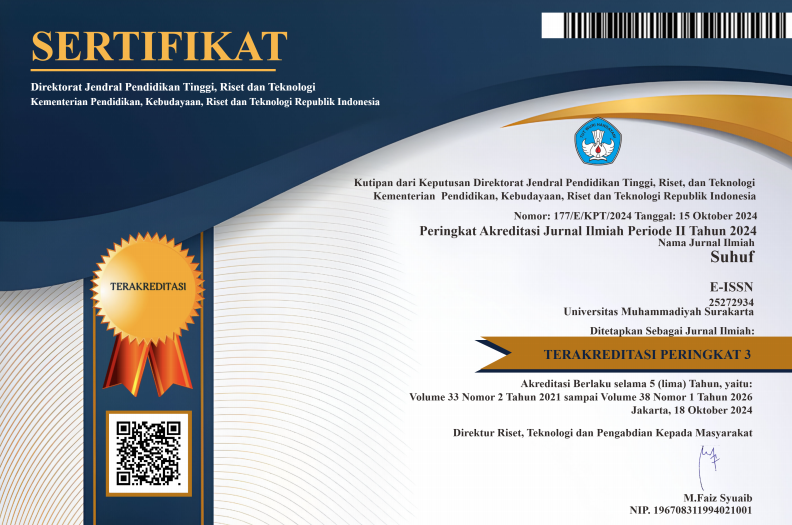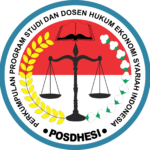Muslim Family Methods on the Negative Impact of Digital Technology Advances in the Era of Industry 4.0 on Children Aged 4-7 in Surakarta
DOI:
https://doi.org/10.23917/suhuf.v36i1.4354Keywords:
Muslim Family, Negative Impact, Digital Technology, Children, ParentingAbstract
The impact of technology on people's lives is enormous, because of the impact of social change that is felt by the whole layer of society, both in the city and in the countryside, not only among adults but also among early children. If the use of technology is inappropriate, then it will bring problems to the lives of the community and in particular make the old people. The study aims to learn about the Muslim family methods regarding the impact of technological advances in the era of Industry 4.0 on early childhood in Surakarta. The method used in this research is qualitative descriptive which includes data reduction, data display, and conclusion. The study finds that the methods applied by the majority of 10 Muslim families regarding the negative impact of digital technology advances in the era of Industry 4.0 on children aged 4-7 in Surakarta, are preventive methods, methods of surveillance, freeing children to play outdoors with peers, selective in choosing appropriate applications for children, being a good example for kids, and giving time limits for children to use technology. In conclusion, this research illuminates the proactive steps taken by Muslim families in Surakarta to navigate the challenges posed by technological advancements. By adopting a range of preventive measures and promoting a balanced approach, these families strive to ensure a positive impact on the lives of their early childhood members amidst the ever-evolving landscape of Industry 4.0.
Downloads
References
N. F. Mayenti and I. Sunita, “Dampak penggunaan gadget terhadap perkembangan anak usia dini di paud dan TK Taruna Islam Pekanbaru,” Phot. J. Sain Dan Kesehat., vol. 9, no. 1, pp. 208–213, 2018, doi: https://doi.org/10.37859/jp.v9i1.1092.
H. K. Yee, C. B. Seok, S. I. Hashmi, T. L. Teng, and R. Indran, “Why Gadget Usage Among Preschoolers Should Matter to Teachers? a Pilot Study,” GESJ Educ. Sci. Psychol., vol. 40, no. 3, pp. 98–111, 2016, [Online]. Available: https://openurl.ebsco.com/EPDB%3Agcd%3A11%3A23755803/detailv2?sid=ebsco%3Aplink%3Ascholar&id=ebsco%3Agcd%3A118765714&crl=c
Kemendikbud, Peraturan Menteri Pendidikan dan Kebudayaan Republik Indonesia Nomor 103 Tahun 2014 Tentang Pembelajaran Pada Pendidikan Dasar dan Pendidikan Menengah. 2014. [Online]. Available: https://peraturan.go.id/id/permendikbud-no-103-tahun-2014
Kominfo, “Kominfo : Pengguna Internet di Indonesia 63 Juta Orang,” KOMINFO. [Online]. Available: https://www.kominfo.go.id/index.php/content/detail/3415/Kominfo+%3A+Pengguna+Internet+di+Indonesia+63+Juta+Orang/0/berita_satker
D. Setiani, “The Effect of Gadget Usage on the Social Development of Children Aged 3-5 Years: Literature Review,” Str. J. Ilm. Kesehat., vol. 9, no. 2, pp. 1732–1739, 2020, doi: https://doi.org/10.30994/sjik.v9i2.526.
N. Hasanah and D. Kumalasari, “Penggunaan Handphone dan Hubungan Teman pada Perilaku Sosial Siswa SMP Muhammadiyah Luwuk Sulawesi Tengah,” Harmon. Sos. J. Pendidik. IPS, vol. 2, no. 1, pp. 55–70, 2015, doi: http://dx.doi.org/10.21831/hsjpi.v2i1.4613.
R. Mustafaoğlu, E. Zirek, Z. Yasacı, and A. R. Özdinçler, “The Negative Effects of Digital Technology Usage on Children’s Development and Health,” Addicta Turkish J. Addict., vol. 5, no. 2, pp. 13–21, 2018, doi: http://dx.doi.org/10.15805/addicta.2018.5.2.0051.
C. Mehler-Wex and M. Kölch, “Depression in Children and Adolescents,” vol. 105, no. 9. pp. 149–155, 2008. doi: https://doi.org/10.3238%2Farztebl.2008.0149.
K. Subrahmanyam, P. Greenfield, R. Kraut, and E. Gross, “The Impact of Computer Use on Children’s and Adolescents’ Development,” J. Appl. Dev. Psychol., vol. 22, no. 1, pp. 7–30, 2001, doi: https://doi.org/10.1016/S0193-3973(00)00063-0.
H. A. Divan, L. Kheifets, C. Obel, and J. Olsen, “Cell Phone Use and Behavioural Problems in Young Children,” J Epidemiol Community Heal., vol. 66, no. 6, pp. 524–529, 2012, doi: https://doi.org/10.1136/jech.2010.115402.
M. K. Maryam, C. P. Kaur, A. Narasimhan, M. Nadeem, M. Ali, and R. B. Shaik, “Impact of Electronic Gadgets on Psychological Behavior of Middle School Children in UAE,” in Gulf Medical Journal, Uni Emirates Arab, 2016, pp. 54–60. [Online]. Available: https://docplayer.net/58819786-Impact-of-electronic-gadgets-on-psychological-behavior-of-middle-school-children-in-uae.html
S. Thomée, A. Härenstam, and M. Hagberg, “Mobile Phone Use and Stress, Sleep Disturbances, and Symptoms of Depression Among Young Adults-a Prospective Cohort Study,” BMC Public Health, vol. 11, no. 1, pp. 1–11, 2011, doi: https://doi.org/10.1186/1471-2458-11-66.
I. Palaiologou, “Children Under Five and Digital Technologies: Implications for Early Years Pedagogy,” Eur. Early Child. Educ. Res. J., vol. 24, no. 1, pp. 5–24, 2016, doi: https://doi.org/10.1080/1350293X.2014.929876.
S. Livingstone, K. Ólafsson, E. J. Helsper, F. Lupiáñez-Villanueva, G. A. Veltri, and F. Folkvord, “Maximizing Opportunities and Minimizing Risks for Children Online: The Role of Digital Skills in Emerging Strategies of Parental Mediation,” J. Commun., vol. 67, no. 1, pp. 82–105, 2017, doi: https://doi.org/10.1111/jcom.12277palai.
F. Gottschalk, “Impacts of Technology Use on Children: Exploring Literature on the Brain, Cognition and Well-Being,” OECD, 195, 2019. doi: https://doi.org/10.1787/8296464e-en.
D. J. Kuss and O. Lopez-Fernandez, “Internet addiction and problematic Internet use: A systematic review of clinical research,” World J. psychiatry, vol. 6, no. 1, p. 143, 2016, doi: https://doi.org/10.5498%2Fwjp.v6.i1.143.
M. F. Ikhwansyah, R. Tanjung, K. A. Maspul, F. Firmanysah, and F. Amalia, “Building Children Character in Islamic Education,” J. Rev. Pendidik. dan Pengajaran, vol. 6, no. 4, pp. 893–897, 2023, doi: https://doi.org/10.31004/jrpp.v6i4.19937.
S. Kamanto, Pengantar Sosiologi, Ed. Rev. Jakarta: Lembaga Penerbit Fakultas Ekonomi Universitas Indonesia, 2004.
D. Setyawan, “KPAI Dorong Pemerintah Bikin Kurikulum Internet Sehat,” KPAI. [Online]. Available: https://www.kpai.go.id/publikasi/kpai-dorong-pemerintah-bikin-kurikulum-internet-sehat
F. Yaşar Ekici, “Parents’ Views on the Use of Technology in the Early Childhood Period,” J. Educ. Train. Stud., vol. 4, no. 12, pp. 58–70, 2016, doi: http://dx.doi.org/10.11114/jets.v4i12.1925.
H. Perbowosari and I. Ketut Sudarsana, “The Role of Parents to Educate Their Children in the Midst of Technology Advancement,” in Proceedings of the 1st Seminar and Workshop on Research Design, for Education, Social Science, Arts, and Humanities, Surakarta: EUDL: European Union Digital Library, 2019. doi: http://dx.doi.org/10.4108/eai.27-4-2019.2286849.
M. Hammer, K. Scheiter, and K. Stürmer, “New Technology, New Role of Parents: How Parents’ Beliefs and Behavior Affect Students’ Digital Media Self-Efficacy,” Comput. Human Behav., vol. 116, pp. 1–9, 2021, doi: https://doi.org/10.1016/j.chb.2020.106642.
E. Zahrotunnisa, “Analisis Faktor-Faktor yang Mempengaruhi Penggunaan E-Wallet Gopay Sebagai Alat Transaksi Terhadap Generasi Z di Pulau Jawa,” UNDIP: Fakultas Ekonomika & Bisnis, 2023. [Online]. Available: https://eprints2.undip.ac.id/id/eprint/15103/
A. Khoirunisa, F. Rohman, H. A. Azizah, D. Ardianti, A. L. Maghfiroh, and A. M. Noor, “Islam in the Midst of AI (Artificial Intelligence) Struggles: Between Opportunities and Threats,” SUHUF, vol. 35, no. 1, pp. 45–52, 2023, doi: https://doi.org/10.23917/suhuf.v35i1.22365.
A. Mujib and J. Mudzakkir, Ilmu pendidikan islam. Jakarta: PT Prenada Media Group, 2021.
R. Astuti, E. Munastiwi, and Muqowim, “Digital Parenting: Utilizing Technology to Instill Islamic Education Values in Young Children,” TADRIS J. Pendidik. Islam, vol. 17, no. 2, pp. 365–379, 2022, doi: https://doi.org/10.19105/tjpi.v17i2.7468.
S. Sugiyono, Metode Penelitian Pendidikan Pendekatan Kualitatif, Kuantitatif dan R & D. Bandung: Alfabeta, 2018.
T. Aryati, “Kontrol Sosial Orang Tua kepada Anak Balita dalam Penggunaan Gadget di Desa Wukirsari Imogiri Bantul,” E-Societas, vol. 6, no. 4, pp. 1–11, 2017, [Online]. Available: https://journal.student.uny.ac.id/ojs/index.php/societas/article/view/9111
M. Sundus, “The Impact of Using Gadgets on Children,” J. Depress. anxiety, vol. 7, no. 1, pp. 1–3, 2018, doi: http://dx.doi.org/10.4172/2167-1044.1000296.
P. Miranti and L. D. Putri, “Waspadai Dampak Penggunaan Gadget Terhadap Perkembangan Sosial Anak Usia Dini,” Jendela PLS J. Cendekiawan Ilm. Pendidik. Luar Sekol., vol. 6, no. 1, pp. 58–66, 2021, doi: https://doi.org/10.37058/jpls.v6i1.3205.
R. Nugroho, I. Artha, W. Nusantara, A. D. Cahyani, and M. Y. P. Patrama, “Peran Orang Tua dalam Mengurangi Dampak Negatif Penggunaan Gadget,” J. Obs. J. Pendidik. Anak Usia Dini, vol. 6, no. 5, pp. 5425–5436, 2022, doi: https://doi.org/10.31004/obsesi.v6i5.2980.
J. Marsh, P. Hannon, M. Lewis, and L. Ritchie, “Young Children’s Initiation into Family Literacy Practices in the Digital Age,” J. Early Child. Res., vol. 15, no. 1, pp. 47–60, 2017, doi: https://doi.org/10.1177/1476718X15582095.
A. Rabiatul Adwiah and D. Raden Rachmy, “Strategi Orang Tua dalam Mengatasi Dampak Penggunaan Gadget Terhadap Perkembangan Sosial Anak Usia Dini,” J. Obs. J. Pendidik. Anak Usia Dini, vol. 7, no. 2, pp. 2463–2473, 2023, doi: https://doi.org/10.31004/obsesi.v7i2.3700.
H. S. Wahyudi and M. P. Sukmasari, “Teknologi dan Kehidupan Masyarakat,” J. Anal. Sosiol., vol. 3, no. 1, pp. 13–24, 2018, doi: https://dx.doi.org/10.20961/jas.v3i1.17444.
D. H. T. Force and C. P. Society, “Screen Time and Young Children: Promoting Health and Development in a Digital World,” Paediatr. Child Health, vol. 22, no. 8, p. 461, 2017, doi: https://doi.org/10.1093%2Fpch%2Fpxx123.
N. Novitasari, “Peran Orangtua dalam Pencegahan Terhadap Kejadian Adiksi Gadget pada Anak: Literatur Review,” Al-Hikmah Indones. J. Early Child. Islam. Educ., vol. 3, no. 2, pp. 167–188, 2019, doi: https://doi.org/10.35896/ijecie.v3i1.53.
Fahrurrozi and Sutrisno, “Pendampingan Orang Tua Dalam Menghadapi Era Digital Bagi Siswa Sekolah Dasar Setiabudi Kecamatan Karet Jakarta Selatan,” J. Pemberdaya. Sekol. Dasar, vol. 1, no. 1, pp. 19–22, 2018, [Online]. Available: https://journal.unj.ac.id/unj/index.php/jpsd/article/view/9694
M. R. Tasya and S. Masitoh, “Pendampingan Orang Tua Kepada Anak Dalam Mencegah Dampak Negatif Dari Gadget,” J. Ris. Mhs. Dakwah dan Komun., vol. 2, no. 5, pp. 229–235, 2020, doi: http://dx.doi.org/10.24014/jrmdk.v2i5.10556.
E. Sutriyatna, “Sosialisasi Dampak Penggunaan Gadget Terhadap Anak-Anak (studi kasus warga rw. 05 kelurahan pondok petir),” KOMMAS J. Pengabdi. Kpd. Masy., vol. 1, no. 1, pp. 133–138, 2020, [Online]. Available: https://openjournal.unpam.ac.id/index.php/kommas/article/view/4616
S. B. Abd Samad and S. H. Haron, “The Impact of Spatial Design to Avoid Gadget Addiction Among Children,” ARTEKS J. Tek. Arsit., vol. 8, no. 1, pp. 1–8, 2023, doi: https://doi.org/10.30822/arteks.v8i1.1224.
I. Nurhidayah, J. G. Ramadhan, I. Amira, and M. Lukman, “Peran Orangtua dalam Pencegahan terhadap Kejadian Adiksi Gadget pada Anak: Literatur Review,” J. Ilmu Keperawatan Jiwa, vol. 4, no. 1, pp. 129–140, 2021, doi: https://doi.org/10.32584/jikj.v4i1.787.

Downloads
Submitted
Accepted
Published
How to Cite
Issue
Section
License
Copyright (c) 2024 Anita Wardani, Annafi Nurul Ilmi Azizah, Muhammad Jafar Nashir

This work is licensed under a Creative Commons Attribution 4.0 International License.


















